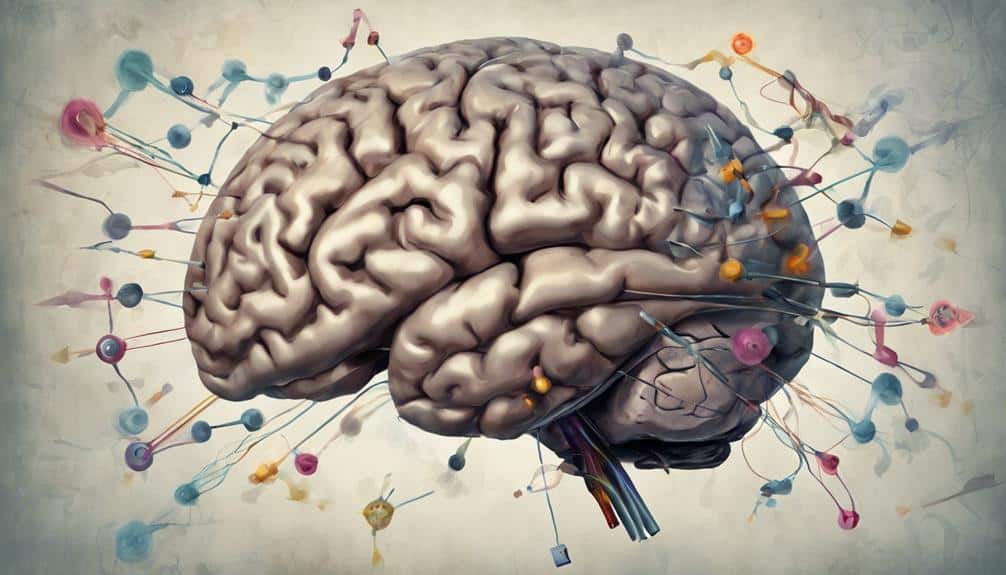Hypermobility and Adhd
Having hypermobile joints might not seem like it could be connected to attention-deficit/hyperactivity disorder (ADHD), but recent studies have uncovered a surprising correlation between these two seemingly unrelated conditions.
The intricate relationship between hypermobility and ADHD raises intriguing questions about potential shared underlying factors that could revolutionize our approach to managing these conditions.
Stay tuned as we unravel the fascinating intersection of hypermobility and ADHD, shedding light on how understanding this connection could lead to more effective interventions and support strategies for those affected.
Key Takeaways
- Generalised Joint Hypermobility (GJH) shows a significant association with adult ADHD.
- Joint pain, instability, and motor challenges are common in individuals with hypermobility and ADHD.
- Shared neural pathways and cognitive processing differences may underlie the connection between hypermobility and ADHD.
- Multidisciplinary interventions, including exercise, therapy, and professional evaluation, are crucial for managing ADHD and hypermobility.
Understanding Hypermobility and ADHD Relationship

Frequently, research has elucidated a strong association between Generalised Joint Hypermobility (GJH) and adult ADHD, emphasizing a compelling link warranting further investigation into potential underlying systemic connections. In a recent study involving 431 adults with ADHD and 417 non-ADHD controls, a significant association between ADHD and GJH was found, even in symptomatic cases. These findings suggest that GJH could serve as an indicator of an underlying systemic disorder involving connective tissue and the central nervous system in individuals with ADHD.
Understanding the relationship between hypermobility and ADHD is essential for unraveling the mechanisms that tie these two conditions together. It's evident that there's more to this association than meets the eye, and further research is imperative to explore deeper into the intricate connections between ADHD and hypermobility. By exploring the underlying systemic disorder, connective tissue involvement, and the impact on the central nervous system, we can gain a better understanding of the complexities of this relationship and potentially uncover novel treatment approaches.
Common Symptoms of Hypermobility and ADHD

Common Symptoms of Hypermobility and ADHD manifest in individuals through a combination of musculoskeletal issues and autonomic dysfunction, potentially impacting both physical and cognitive functions. The following are key symptoms observed in individuals with both hypermobility and ADHD:
- Joint Pain and Instability: Individuals with hypermobility and ADHD may experience chronic joint pain and instability, leading to discomfort and potential limitations in physical activities.
- Motor Coordination Challenges: Hypermobility can contribute to difficulties in motor coordination for individuals with ADHD, affecting their ability to perform tasks that require precise movements.
- Impaired Fine Motor Skills: The joint instability associated with hypermobility in individuals with ADHD can also impact fine motor skills, making tasks like writing, typing, or buttoning clothes more challenging.
Understanding these common symptoms is essential in developing interventions that target both the physical and cognitive aspects of hypermobility and ADHD to improve overall functioning and quality of life.
Potential Overlapping Mechanisms Explained

Upon analysis, shared neural pathways could underlie the connection between hypermobility and ADHD, potentially influencing both conditions.
Cognitive processing differences may also play a role in the overlapping mechanisms between these two disorders, affecting how individuals with ADHD and hypermobility navigate their environments.
Additionally, the functional impact on daily activities due to these shared mechanisms warrants further investigation to enhance treatment strategies for affected individuals.
Shared Neural Pathways
Exploring the shared neural pathways between hypermobility and ADHD reveals potential overlapping mechanisms in the central nervous system. This connection suggests a deeper association beyond just the co-occurrence of symptoms. Here are key points to ponder:
- Joint Hypermobility and Systemic Disorders: Research indicates a significant link between adult ADHD and joint hypermobility, pointing towards common underlying systemic disorders that may contribute to both conditions.
- Autonomic Dysfunction and Dysautonomia: Individuals with ADHD and hypermobility may experience symptoms related to autonomic dysfunction and dysautonomia, indicating a potential shared physiological aspect.
- Frontal-Striatal Circuitry: Implications of frontal-striatal circuitry in symptom expression across ADHD and hypermobility conditions suggest a neurobiological basis for the observed overlap. Understanding these shared neural pathways can guide treatment approaches for individuals with both conditions.
Cognitive Processing Differences
Investigating cognitive processing disparities between individuals with ADHD and hypermobility reveals potential converging pathways that may underlie shared cognitive challenges in these conditions.
Altered sensory processing, attention regulation, and executive function are key areas where overlaps exist. Difficulties in sensory integration could contribute to information processing inefficiencies.
Both ADHD and hypermobility can affect cognitive flexibility, working memory, and motor coordination, impacting daily functioning and task performance. The complex interplay of neurodevelopmental and physical health factors likely influences cognitive processing abilities in individuals with these conditions.
Understanding the cognitive similarities and differences in ADHD and hypermobility is pivotal for developing targeted interventions that address both the neurodevelopmental and musculoskeletal aspects of these disorders.
Functional Impact on Daily
The functional impact of hypermobility and ADHD on daily activities manifests through a range of overlapping mechanisms that exacerbate physical, cognitive, and sensory challenges experienced by individuals with both conditions.
- Joint instability in individuals with hypermobility and ADHD can lead to difficulties in motor coordination, affecting tasks such as writing or playing sports.
- Cognitive challenges may arise from the combination of ADHD and hypermobility, impacting attention, executive functions, and processing speed during daily activities.
- Sensory sensitivities in those with both conditions can result in heightened responses to stimuli, making it challenging to focus or remain calm in noisy or crowded environments.
Managing the daily functioning of individuals with hypermobility and ADHD necessitates a thorough, multidisciplinary approach that addresses the physical, cognitive, and emotional aspects of the disorder to optimize overall well-being.
Impact of Hypermobility on ADHD Management

Individuals with ADHD exhibit a significant association with generalised joint hypermobility (GJH) and symptomatic GJH, indicating a potential systemic disorder involving connective tissue and the central nervous system.
A study involving 431 adults with ADHD and 417 non-ADHD controls highlighted a notable link between ADHD and GJH, underlining the need to explore into the underlying mechanisms for improved management.
The shared pathophysiology between ADHD and joint hypermobility implies that treatment approaches and interventions for individuals with ADHD could be influenced by this relationship.
Recognizing the impact of hypermobility on ADHD management is important for enhancing healthcare services and developing more targeted and effective management strategies.
By understanding the association between hypermobility and ADHD, healthcare providers can offer better support, leading to improved outcomes, early diagnosis, and tailored assistance for individuals with ADHD and related joint hypermobility conditions.
This insight paves the way for a more thorough and personalized approach to managing ADHD in individuals with hypermobility.
Strategies for Supporting Individuals With Both Conditions

Exploring tailored strategies to support individuals concurrently managing hypermobility and ADHD involves integrating targeted interventions for optimizing joint health, attention, and cognitive function.
- Tailored Exercise Programs: Implementing exercise regimens focused on stability and strength can aid in preserving joint health while also enhancing attention and focus in individuals with hypermobility and ADHD.
- Occupational Therapy: Engaging in occupational therapy sessions can assist in developing coping strategies for sensory sensitivities, refining organizational skills, and improving motor coordination, thereby supporting individuals in managing both conditions effectively.
- Cognitive Behavioral Therapy (CBT) and Mindfulness Techniques: Utilizing CBT to address anxiety and emotional regulation challenges, alongside incorporating mindfulness techniques like deep breathing exercises and grounding activities, can empower individuals with hypermobility and ADHD to reduce stress, enhance self-awareness, and bolster their coping mechanisms.
Seeking Professional Help for Hypermobility and ADHD

When seeking professional help for hypermobility and ADHD, it's vital to consult with a range of healthcare specialists, including rheumatologists, orthopedic specialists, and neurologists.
A thorough evaluation may involve physical examinations, joint mobility tests, symptom assessments, and detailed medical history reviews to develop a complete treatment plan.
Treatment options may encompass physical therapy, occupational therapy, pain management strategies, and medication management to address the unique needs of individuals with both hypermobility and ADHD.
Professional Evaluation for Hypermobility
Considering the potential impact on physical health, seeking professional evaluation for hypermobility in individuals with ADHD is essential for identifying joint hypermobility and determining appropriate management strategies. When undergoing a professional evaluation for hypermobility, individuals with ADHD may expect the following:
- Utilization of physical assessments such as the Beighton score to quantify the degree of joint hypermobility.
- Assessment of hypermobility symptoms severity and correlation with ADHD for tailored management strategies.
- Evaluation aimed at recognizing potential systemic disorders involving connective tissue and the central nervous system to guide early detection and targeted interventions for improved outcomes.
Treatment Options for ADHD
To effectively manage both hypermobility and ADHD symptoms, seeking professional help is essential for tailored treatment options and improved quality of life. Treatment options for ADHD encompass a range of interventions, including medication, therapy, and lifestyle modifications specific to individual requirements and symptomatology.
In the case of hypermobility, physical therapy and targeted exercises play a critical role in addressing joint stability issues and enhancing overall function. Collaborating with a multidisciplinary team, comprising specialists in ADHD and hypermobility, guarantees complete care that addresses the complexities of both conditions.
Regular monitoring and adjustments to treatment plans are crucial to optimize symptom management and adapt to any changes that may arise. By engaging with diverse treatment modalities and a coordinated healthcare approach, individuals can better navigate the challenges posed by hypermobility and ADHD.
Lifestyle Adjustments for Better Quality of Life

To enhance the quality of life for individuals with ADHD and hypermobility, incorporating regular physical therapy sessions to strengthen muscles around hypermobile joints is essential. This vital approach can improve joint stability and reduce the risk of injuries commonly associated with hypermobility.
Alongside physical therapy, implementing a balanced exercise routine is critical for individuals with ADHD and hypermobility. Such routines can further enhance joint stability, providing better support for hypermobile joints and reducing the likelihood of dislocations or strains.
Additionally, maintaining a healthy diet that includes essential nutrients like calcium and vitamin D plays a key role in supporting bone and joint health in individuals with these conditions. This nutritional focus can help mitigate the impact of hypermobility on bone density and overall joint function, contributing to a better quality of life.
Frequently Asked Questions
Is Hypermobility Correlated With Adhd?
Hypermobility prevalence and Adhd relationship can be complex. Joint laxity may influence Adhd symptoms. Connective tissue considerations are important for Adhd diagnosis. Hypermobility assessment could impact Adhd treatment. Research into underlying mechanisms is essential for effective interventions.
What Disorders Are Associated With Hypermobility?
Oh, the myriad of disorders linked to hypermobility! From EDS to joint pain, connective tissue issues, and genetics playing a role. Physical therapy, stretching exercises, even dancing and sports injuries are part of the mix.
Is Hypermobility Linked to Neurodivergence?
Yes, hypermobility is linked to neurodivergence. Research shows a significant association between hypermobility and conditions like autism, ADHD, and Tourette syndrome. The prevalence of hypermobility is higher in neurodivergent individuals, impacting their well-being.
What Are 7 Signs You Have Hypermobility?
Bending thumbs to touch forearms, elbows, knees hyperextend, signs of joint hypermobility. Assess with Beighton Score, measure flexibility. Joint pain, frequent sprains, dislocations common. Awareness essential for exercise modifications, treatment, prevention, especially in athletes and children.
Conclusion
To sum up, the intriguing interplay between hypermobility and ADHD presents a puzzle worth pondering. Understanding the shared symptoms and potential mechanisms can provide valuable insights for effective management strategies.
By seeking professional help and making lifestyle adjustments, individuals with both conditions can aim for a better quality of life. The fascinating fusion of flexibility and focus offers a fresh perspective on the complex connection between mind and body.







